
Isabella d'Este was Marchioness of Mantua and one of the leading women of the Italian Renaissance as a major cultural and political figure.

Jacopo Bellini was one of the founders of the Renaissance style of painting in Venice and northern Italy. His sons Gentile and Giovanni Bellini, and his son-in-law Andrea Mantegna, were also famous painters.

Andrea Mantegna was an Italian painter, a student of Roman archeology, and son-in-law of Jacopo Bellini.

Lorenzo Costa was an Italian painter of the Renaissance.
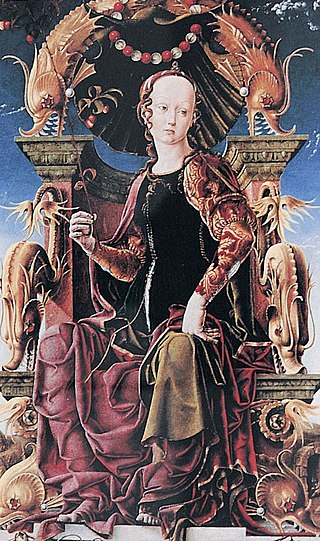
Cosmê Tura, also known as Il Cosmè or Cosimo Tura, was an Italian early-Renaissance painter and considered one of the founders of the School of Ferrara.
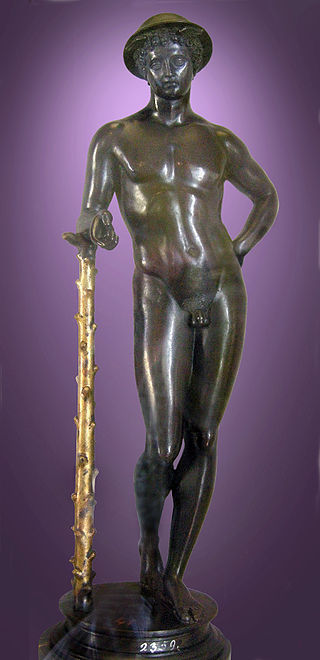
Pier Jacopo Alari Bonacolsi, called L'Antico by his contemporaries, and often Antico in English, the nickname given for the refined interpretation of the Antique they recognized in his work, was a 15th- and 16th-century Italian Renaissance sculptor, known for his finely detailed small bronzes all'Antica—coolly classicizing, often with gilded details, and silver-inlaid eyes, a refinement that is found in some classical and Hellenistic Greek bronzes.

The Palazzo Ducale di Mantova is a group of buildings in Mantua, Lombardy, northern Italy, built between the 14th and the 17th century mainly by the noble family of Gonzaga as their royal residence in the capital of their Duchy. The buildings are connected by corridors and galleries and are enriched by inner courts and wide gardens. The complex includes some 500 rooms and occupies an area of c. 34,000 m2, which make it the sixth largest palace in Europe after the palaces of the Vatican, the Louvre Palace, the Palace of Versailles, the Royal Palace of Caserta and the Castle of Fontainebleau. It has more than 500 rooms and contains seven gardens and eight courtyards. Although most famous for Mantegna's frescos in the Camera degli Sposi, they have many other very significant architectural and painted elements.

Lorenzo Leonbruno, also known as Lorenzo de Leombeni, was an Italian painter during the early Renaissance period. He was born in Mantua (Mantova), an Italian commune in Lombardy, Italy. Leonbruno is most well known for being commissioned by the court of Francesco Gonzaga, Marquis of Mantua, and his wife Isabella d'Este. The patronage continued with their eldest son Federico II Gonzaga, who was the fifth Marquis of Mantua. Leonbruno was the court painter for the Gonzaga family from 1506–24.

The Triumph of the Virtues is a painting by the Italian Renaissance painter Andrea Mantegna, completed in 1502. It is housed in the Musée du Louvre of Paris.
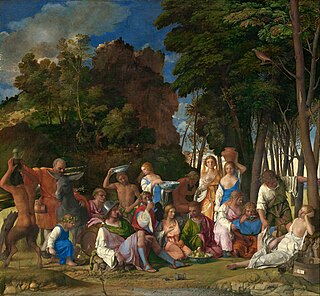
The Feast of the Gods is an oil painting by the Italian Renaissance master Giovanni Bellini, with substantial additions in stages to the left and center landscape by Dosso Dossi and Titian. It is one of the few mythological pictures by the Venetian artist. Completed in 1514, it was his last major work. It is now in the National Gallery of Art in Washington D.C., which calls it "one of the greatest Renaissance paintings in the United States".

Francesco Bonsignori, also known as Francesco Monsignori, was an Italian painter and draughtsman, characterized by his excellence in religious subjects, portraits, architectural perspective and animals. He was born in Verona and died in Caldiero, a city near Verona. Bonsignori's style in early period was under the influence of his teacher Liberale da Verona. After becoming the portraitist and court artist to the Gonzaga family of Mantua in 1487, his style was influenced by Andrea Mantegna, who also worked for Francesco Gonzaga from the 1480s. They collaborated to execute several religious paintings, mainly with the theme of Madonna and Child. The attribution of theportrait of a Venetian Senator was debatable until the last century because of the similarity in techniques used by Bonsignori and his teacher Mantegna. During the phase of his career in Mantua, there is an undocumented period between 1495 and July 1506 with no official record regarding his activities by the court of Mantua. Bonsignori's late style was decisively influenced by Lorenzo Costa in terms of form and color. He produced his last monumental altarpiece the Adoration of the Blessed Osanna Andreasi in 1519 shortly before his death.
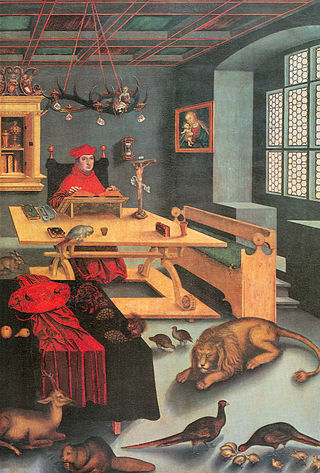
A cabinet was a private room in the houses and palaces of early modern Europe serving as a study or retreat, usually for a man. The cabinet would be furnished with books and works of art, and sited adjacent to his bedchamber, the equivalent of the Italian Renaissance studiolo. In the Late Medieval period, such newly perceived requirements for privacy had been served by the solar of the English gentry house, and a similar, less secular purpose had been served by a private oratory.

The Battle Between Love and Chastity is a painting by the Italian Renaissance artist Pietro Perugino, now in the Musée du Louvre, in Paris, France. It was originally commissioned for the studiolo (cabinet) of Isabella d'Este, Marchesa of Mantua, in the Castello di San Giorgio.
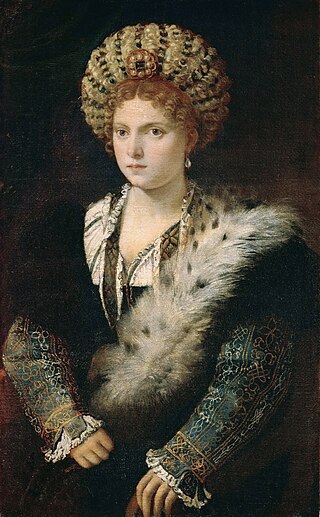
Isabella in Black is a portrait of a young woman by Titian. It can be dated to the 1530s and is in the Kunsthistorisches Museum in Vienna. The artist and the date are undisputed. Beyond the museum documentation, there are repeated doubts about the person depicted.

The Allegory of Isabella d'Este's Coronation is a painting by the Italian Renaissance painter Lorenzo Costa, dating to about 1505–1506. It is displayed in the Louvre, in Paris.

The Parnassus is a painting by the Italian Renaissance painter Andrea Mantegna, executed in 1497. It is housed in the Musée du Louvre of Paris.

The Allegory of Vice is an oil on canvas painting by Correggio dating to around 1531 and measuring 149 cm (59 in) by 88 cm (35 in).

The Allegory of Virtue is an oil on canvas painting by Correggio dating to around 1531 and measuring 149 by 88 cm. It and Allegory of Vice were painted as a pair for the studiolo of Isabella d'Este, with Vice probably the second of the two to be completed. This hypothesis is since only one sketch survives for Vice, unlike Virtue, for which two preparatory studies survive, along with a near-complete oil sketch - this suggests Correggio had become more proficient after the difficult gestation of Virtue.
The Introduction of the Cult of Cybele at Rome is a painting in glue tempera on canvas by Andrea Mantegna. Measuring 73.5 cm by 268 cm, It was produced in 1505–1506 and is now in the National Gallery in London. Like much of Mantegna's output after 1495 it is in monochrome, linked to contemporary sculpture and also part of the trend for illusion and trompe-l'œil favoured by the Mantuan court and especially by Isabella d'Este.
The Studiolo of Isabella d'Este was a special private study, first in castello di San Giorgio, later the Studiolo was moved to the Corte Vecchi apartments in the Ducal Palace in Mantua, designed by, and with a collection of art specially commissioned by Isabella d'Este.


















